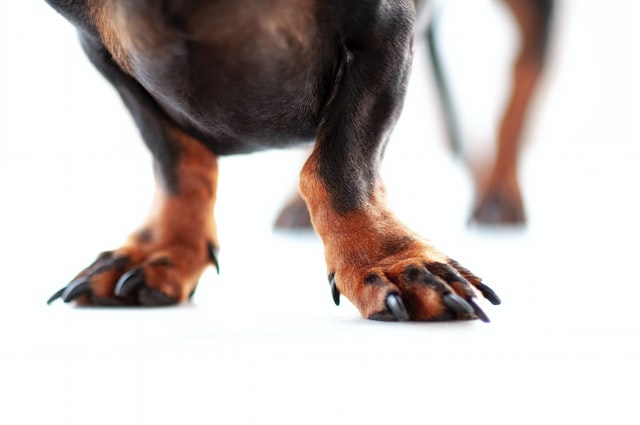How to Help a Dog With Cracked or Broken Toenails
Posted: 09/15/2022 | BY: Erin Cain | Categories: Dog , Health problems , Pet care , Top Tips
Dogs with cracked and broken toenails suffer from painful injuries. Not only do broken toenails make it challenging to walk, but a nail injury can become infected and cause significant discomfort. This blog post will discuss how to help your dog with this common problem. We will cover causes, symptoms, and treatment options so pet owners can know what to do should their pup hurt herself. So if your dog is suffering from cracked or broken toenails, read on for some helpful advice!

Toenail anatomy and injured nail beds
Dog’s nails are comparable to human toes and fingers. The canine nail itself can be compared in structure but tends toward thicker dimensions; it also wraps around the tip of the toe. Unlike the human foot, which lies flat, the canine toe is slightly curved.
However, similarly to human nails, a dog’s toe attaches to the layer beneath the skin, called the underlying dermis, and has an insensitive and unattached part that comes to a point. The dog’s quick, the part of its dermis attached to the nail, is highly sensitive. It has an impressive blood supply, which is one reason why a broken or cracked toenail may bleed profusely.
The dermis also covers the bone on the last joint of the toe. Because the dog’s toenail wraps around the point of its toe, it naturally makes contact with the ground more often than humans’ toes do. Due to the way dogs use their toenails, the nails are prone to splitting and breaking. They can also experience a cracked or broken nail during normal canine activities, such as scratching and digging.
Perhaps most important, dogs need their toenails trimmed regularly. A long nail can cause a broken toenail due to snagging or catching on carpeting, clothes, flooring, or anything that the nail comes in contact with.

What are the signs of torn or broken toenails?
If your dog exhibits the following behaviors, you may want to examine her feet for a broken nail:
- excessive licking of the claws or paws
- discolored nails
- limping, holding up the paw, refusing to put weight on the foot
- brittle nails
- redness and swelling of the nail or the quick
- discharge or bleeding of the nail or nail bed
These are some of the most common signs that your dog may need veterinary attention.

What to do about a dog’s broken toenails
After your dog breaks a nail, your next step is to determine what kind of injury your dog has. These are the most common types of toenail injuries that dogs may experience:
Broken off toenails
A completely broken off dog’s nail is the best case scenario for a canine nail injury. In these cases, there’s generally no bleeding or only mild bleeding. As long as the bleeding is not intensive, you can care for this situation at home before contacting your veterinarian for further advice. Make sure you have a pet first aid kit handy for this medical situation. Apply pressure gently to the broken nail with a clean cloth or gauze; keep that pressure steady for 5 to 10 minutes without letting up during that time frame.
If you notice that the bleeding has not stopped despite applying pressure after 10 minutes, you can use styptic powder or baking soda on the wound. Resume the applied pressure for another 5 to 10 minutes. Contact the nearest emergency clinic or your veterinarian immediately if the bleeding does not stop.
Loosely attached cracked or broken toenails
If your dog’s nail is torn and dangling or loose, you can try to remove it before contacting the vet for assistance carefully. In this case, it’s best if someone can safely hold your dog and the dog’s paw while you try to remove the hanging nail in one quick pulling motion gently. Only attempt this removal if the nail is truly loose and dangling.
Take care when removing any nails as this can cause an unpleasant, painful sensation which may cause some dogs to bite or nip out of fear and surprise. A broken toenail may be a minor injury, but it is extremely painful.
Firmly attached fractured or broken toenails
Veterinary care is a must for cracked or broken toenails that are still firmly attached to the toe. Do not attempt to resolve this level of injury on your own. The vet will examine the wound and typically give your dog some form of sedation with pain medication. Then, they will cut off the damaged nail just above where it has broken or cracked.
Because cutting through the nail with a live blood vessel and the nerve is very painful, sedation is necessary to keep your pup comfortable and still. The veterinarian will apply a styptic pencil or styptic powder to stop the bleeding and then bandage it for 24 hours. The bandage promotes wound healing, encourages the development of clotting, and keeps the injury safe in case your dog bumps or trips on something. Dogs with this level of toe injury will likely have to wear an elizabethan collar or e-collar until the toenail has healed.

When to see the veterinarian for treatment
You should take your dog to the vet immediately if the nail has a significant break and is bleeding a lot. If you find a nail that has broken near the base, apply gentle and steady pressure to slow or stop the bleeding. Your dog should see a vet who can remove the nail. If necessary, the vet will treat your dog with pain medications and antibiotics to prevent infection.
Broken nails are rarely severe injuries for most dogs. However, if the injury is left untreated and the wound bleeds profusely, it may cause a life-threatening situation.
Why do my dog’s toenails break so often?
The common cause of broken nails in dogs is often an underlying medical issue. Chronic or persistent fungal infections that produce brittle nails, immune-mediated diseases such as lupoid onychodystrophy, and nutritional pet food deficiencies can lead to brittle toenails that break easily.
If your pup likes to dig, they might frequently experience broken nails. Your vet will assess your furry friend’s feet, diagnose any underlying problems causing this condition, and begin appropriate treatments.

How to prevent a toenail injury
You can limit the chances of your dog experiencing a broken or cracked toenail by doing the following:
- give your dog a nail trim regularly; if your dog doesn’t like clippers, try using a nail grinding tool;
- walk your dog frequently on hard surfaces, such as sidewalks or pavement, to wear down the nails naturally. Long nails can get snagged, so keeping the nails short is key. Please note that a dog’s dew claws, which don’t touch the ground, are not subject to this type of injury;
- discourage your dog from digging.
If your dog continues to break her nails, contact your vet to have your dog examined.

Pet insurance protects your pup from her head to her toes.
Pet insurance protects your pup from her head to her tail to her toes. When unexpected injuries occur, you can count on your dog’s health insurance plan to get her the best veterinary treatment. Plus, the provider can reimburse your vet bills up to 90% depending on your policy choice.
Pet Insurance Review works to help all pet parents afford their pet’s emergency coverage. We’ll find the right health plan options for your dog! Get your pup’s free quote today.
References:
- Buzby, J. (2022). Dog Toenail Anatomy 101. Retrieved from https://toegrips.com/dog-toenail-anatomy/
- Schurr, B. (2018). What exactly is a dog’s “quick”? Retrieved from https://www.thenailpawlor.com/post/copy-of-pet-allergies
- Meyers, H. (2020). Trim Your Dog’s Nails Safely. Retrieved from https://www.akc.org/expert-advice/health/how-to-trim-dogs-nails-safely/
- ASPCAPro. (2021). How to Make a Pet First Aid Kit. Retrieved from https://www.aspcapro.org/resource/how-make-pet-first-aid-kit
- Easter, F. (2017). Using Styptic Powder to Stop Dog Nail Bleeding. Retrieved from https://www.dogtrainingnation.com/tag/how-to-put-styptic-powder-to-dog-nails/
- Donovan, D. (2022). Symptoms of Dog Nail Fungus. Retrieved from https://dogs.lovetoknow.com/wiki/Symptoms_of_Dog_Nail_Fungus
- Pinchbeck, L. (2022). SYMMETRIC LUPOID ONYCHODYSTROPHY (AKA SYMMETRIC LUPOID ONYCHITIS) IN DOGS. Retrieved from https://www.medvetforpets.com/symmetric-lupoid-onychodystrophy-aka-symmetric-lupoid-onychitis-in-dogs/
- My First Shiba. (n.d.). Dog Nail Grinder — What Are Dog Nail Grinders Used For? Retrieved from https://myfirstshiba.com/dog-nail-grinder/
- Valentini, K. (2022). What the Heck are Dewclaws and Why Do Dogs Have Them? Retrieved from https://www.dailypaws.com/dogs-puppies/health-care/dew-claw
The information contained on this blog is intended for informational and educational purposes only and should not be construed as medical advice. It is not a substitute for professional veterinary care. Always consult with your veterinarian before making any changes to your pet's health care or treatment plan.
The authors of this blog are not veterinarians and do not claim to be experts in pet health. The information provided here is based on our own experiences and research, as well as information from reputable sources. However, we cannot guarantee the accuracy or completeness of this information.
We encourage you to do your own research and consult with your veterinarian before making any decisions about your pet's health.
Previous post
Things to Know When Rescuing a PuppyNext post
How to Recognize a Real Pet EmergencyCompare top pet insurance providers & plans.
Enter your dog’s age in years and months to calculate their age equivalent to human years.
Calculate your dog’s ageEnter your cat’s age in years and months to calculate their age equivalent to human years.
Calculate your cat’s age